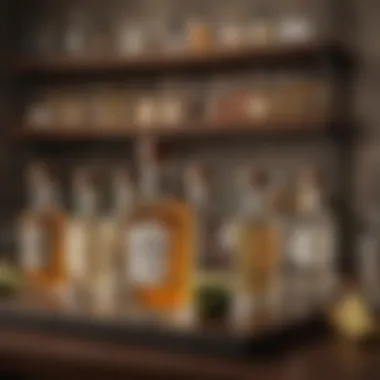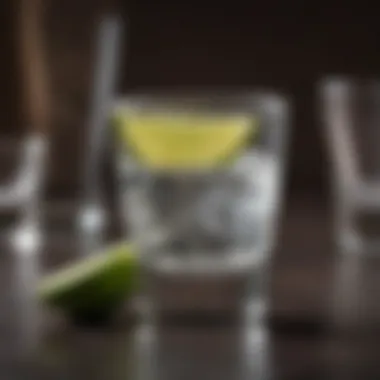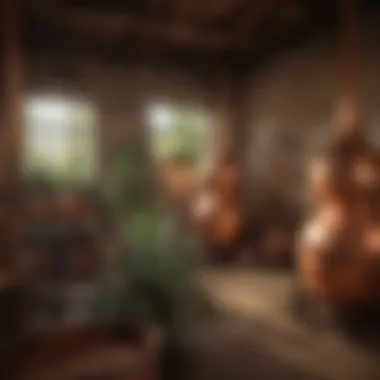Discover the Finest Tequila for Shots


Intro
Tequila is not just a drink; it's an experience steeped in rich culture and tradition. For many, taking shots of tequila is synonymous with celebrations and social gatherings. However, choosing the right tequila for this purpose is crucial. In this article, we will explore the various options available to you when it comes to selecting the best tequila for shots. We will look into the unique characteristics of different types of tequila, examining their flavor profiles and production methods. Furthermore, we will balance this information with the cultural significance of tequila consumption.
Understanding tequila’s complexities will enable both novices and seasoned enthusiasts to make informed choices. Whether you're preparing for a night out or simply looking to enhance your home collection, being aware of the nuances of tequila can enhance your enjoyment and appreciation. With that said, let’s delve into the overview of what can best tickle your palate when opting for shots.
Recipe Overview
Brief Summary of the Recipe Taking shots of tequila is simpler than it appears, yet the choice of tequila can dramatically influence the experience. To enjoy tequila shots fully, it's essential to select a spirit that delights the senses while also being smooth enough to savor.
Key Ingredients and Tools Needed
While the essential ingredient is tequila itself, several factors can enhance the experience:
- Types of Tequila: Blanco, Reposado, Añejo. Each lends different flavor profiles.
- Salt: A classic accompaniment for those who prefer a savory edge.
- Lime: Enhances flavor and balances tequila’s strong effects.
- Shot Glasses: Appropriate glassware elevates the experience.
Step-by-Step Instructions
Choosing the Right Tequila
- Identify Your Preference: Understand the flavor profiles. For clean, crisp notes, a Blanco is ideal. For richer, more complex flavors, consider Reposado or Añejo.
- Research Brands: Familiarize yourself with reputable brands like Patron, Don Julio, and Espolon, each offering unique qualities.
- Consider the Price Point: Quality often correlates with price. Determine your budget but remember, cheaper options may compromise flavor.
Preparing for the Shot
- Chill the Tequila: Many enjoy tequila cold; consider placing it in the freezer for a short while.
- Gather Accompaniments: Have salt and lime ready if desired, as they can complement the shot well.
- Select Proper Glassware: Use a clean shot glass to enhance the drinking experience.
Taking the Shot
- Salt the Hand or Rim: If using salt, apply it to your hand or the rim of the glass.
- Slice the Lime: Make sure the lime is cut and readily accessible.
- Enjoy the Shot: Raise your glass, take the shot in one swift motion, and bite into the lime afterward for a refreshing contrast.
Cultural Significance
Taking tequila shots has a social connotation, often shared among friends in informal settings. This practice transcends borders; it integrates into rituals and celebrations globally. It is worth mentioning that a deeper understanding of tequila's origins can enrich the drinking experience.
"Tequila is a cultural symbol that embodies the craftsmanship and spirit of Mexico."
Culmination
As we have explored, finding the best tequila for shots involves more than just picking a bottle. The choice spans various factors, from the type of tequila to the cultural practices surrounding its consumption. Knowing these elements will not only enhance your shots but also reveal a deeper appreciation for the significant role tequila plays in social gatherings.
Understanding Tequila
Tequila is not simply a spirit; it embodies a rich culture and deep-rooted traditions. Understanding tequila is essential for anyone seeking to appreciate its diverse offerings, especially when considering the best tequila for shots. The nuances in flavor, production, and regional variations can significantly influence the overall experience. This section explores what defines tequila, its various types, and the production processes that give each variant its unique characteristics.
Definition of Tequila
Tequila is a distilled alcoholic beverage crafted from the blue agave plant, primarily in the region surrounding the city of Tequila in Mexico. It must contain at least 51% agave, according to Mexican regulations, although many premium brands exceed this threshold by using 100% agave. The distinct flavor profile of tequila is heavily influenced by the type of agave used, the soil where it is grown, and the production methods employed.
Types of Tequila
Tequila is categorized into several types, each offering a unique taste and experience. Identifying these variations is crucial when selecting tequila for shots.
Blanco
Blanco tequila, often referred to as silver tequila, is unaged and bottled immediately after distillation. Its fresh and vibrant flavor profile makes it a popular choice. Blanco tequilas are known for their crisp and clean taste, often displaying bold notes of agave and pepper. This type is beneficial for shots due to its potent flavors and straightforward nature, allowing for an authentic tequila experience.
Reposado
Reposado tequila is aged in wooden barrels for a minimum of two months but less than a year. This aging process imparts subtle flavors of oak and spice, softening the sharpness associated with blanco tequila. Reposado is favored for its balance between the fresh agave flavor and the complexity introduced through aging. It offers a smoother shot experience while maintaining significant character.


Añejo
Añejo tequila, aged for over one year but less than three years, provides a deeper and more complex flavor. The aging occurs in smaller barrels, allowing for greater interaction between the tequila and the wood. This results in a rich amber color and a flavor profile filled with notes such as vanilla, caramel, and dried fruit. Añejo’s smoothness and richness make it a sophisticated choice for sipping, though some may still enjoy it in shots, appreciating its depth.
Extra Añejo
Extra Añejo is the top tier of tequila, aged for a minimum of three years. The prolonged aging develops sophisticated flavors and a mellow aroma. These tequilas often boast a high price tag due to the lengthy aging process and care involved in their production. While not the typical choice for shots, extra añejos can elevate specific tasting occasions, catering to connoisseurs looking for a distinctive experience.
Tequila Production Process
The production of tequila involves a series of meticulous steps that shape its final qualities. Each phase plays a vital role in developing the nuances that characterize various tequila types.
Agave Harvesting
The harvesting of the blue agave plant is a crucial first step. Skilled harvesters, or "jimadores," carefully extract the piñas from the agave plants, which can take years to mature. The quality of the agave significantly influences the tequila's flavor, making this step essential for high-quality production. The use of ripe agave ensures the ultimate expression of flavor, directly affecting the final product.
Fermentation
Once the piñas are processed and cooked, they are mashed and left to ferment. Fermentation is where the sugars from the agave convert into alcohol, leading to the creation of the base tequila. The conditions during fermentation, such as temperature and yeast types, can greatly affect flavor development. This stage requires careful monitoring to balance the complexity of flavors needed for the desired tequila type.
Distillation
Following fermentation, the mixture undergoes distillation, a process that separates alcohol from the solids. Typically, distillation occurs twice to refine the spirit. The first distillation produces a low-alcohol substance called "ordinario," which is later distilled again to yield a higher-proof tequila. This step directly impacts tequila purity and flavor, marking an essential part of the production process.
Aging
If the tequila is to be aged, it is transferred into wooden barrels afterward. Aging allows the spirit to absorb characteristics from the wood, enhancing its flavor profile and smoothing its texture. The duration of aging determines the specific type of tequila produced. Understanding this process helps consumers appreciate the differences in taste and aroma that result from varying aging times.
Factors to Consider for Shots
When choosing tequila for shots, it is essential to navigate through several key factors. These factors directly influence the overall experience, making it not just about the alcohol but also about flavor, affordability, and appropriateness for the occasion. Understanding these elements deepens appreciation and enjoyment of tequila.
Flavor Profiles
Tequila comes in various flavor profiles, heavily influenced by its production methods and the type of agave used. Different flavor attributes can enhance or detract from the experience of taking shots.
Sweetness
Sweetness refers to the natural sugary notes that can be present in tequila. While sweetness is not the predominant characteristic of all tequilas, certain brands and types exhibit it more prominently. For instance, Blanco tequila often features a fresh, sweet taste. This quality can ease the palate, making it a beneficial choice for those new to taking shots.
The unique feature of sweetness in tequila is its ability to balance stronger alcohol flavors. This makes sweeter options popular among casual drinkers, as they can mask the burn of the alcohol. However, it’s worth noting that some experienced drinkers may prefer drier varieties, as they offer a truer representation of agave's rich flavor.
Spiciness
Spiciness in tequila refers to the peppery and zesty sensations it can evoke. Often, this characteristic emerges from the aging process or the specific agave strains used. Tequila with a spicy profile can add depth to the shots, providing a more complex flavor.
This profile tends to appeal to those seeking a more intense experience. The unique attribute of spiciness means it can enhance flavor perception, making it an engaging choice for seasoned drinkers. However, it can also be overwhelming for beginners, who might find it less enjoyable.
Earthiness
Earthiness in tequila represents robust and deep flavors reminiscent of the soil from where the agave is grown. This profile often connects drinkers to the terroir of tequila production, enhancing appreciation for its origins. Tequilas with an earthy character can evoke a sense of authenticity.
Earthy tequila appeals to traditionalists and offers a unique charm, linking drinkers to culture and authenticity. However, this flavor can sometimes be too intense for some, making a careful selection crucial.
Alcohol Content
The alcohol content of tequila is another important consideration. Generally, tequila is distilled at 40% alcohol by volume (ABV), but many brands offer higher proofs. Tequilas with higher alcohol content can provide a more intense experience, which may be preferred by enthusiasts.
Nonetheless, high alcohol content can also increase the risk of overconsumption, making it essential to drink responsibly.


Price Range
An important aspect of selecting tequila for shots is the price range. Prices vary widely based on production methods, aging, and branding.
Budget Options
Budget options can provide reasonable quality at a lower price point. These tequilas are often unaged and focus on raw agave essence. Popular among beginners, budget brands like Olmeca and Jose Cuervo serve well for casual gatherings. However, lower price might compromise on taste or experience, which should be kept in mind.
Mid-Range Choices
Mid-range choices typically balance quality and affordability. They offer better flavor profiles compared to budget options. Brands like Espolon and Típico prove competitive, providing a good taste experience without breaking the bank. The unique feature of mid-range tequilas is their capacity to cater to a broader audience. However, some may still not meet the expectations of discerning drinkers.
Premium Selections
Premium selections often represent the pinnacle of tequila craftsmanship. Brands such as Don Julio and Patrón focus on quality ingredients and meticulous production. These tequilas can deliver rich flavors and a smooth experience, making them ideal for special occasions or savoring moments.
The unique aspect of premium selections lies in their ability to provide a richer narrative of tequila’s heritage. Yet, the higher price could make them less accessible for some consumers.
Ultimately, understanding these factors will inform better choices when selecting tequila for enjoyable shots.
Top Brands for Shots
The topic of Top Brands for Shots is central to this article. It highlights the diversity present in the tequila market and the possibilities available to consumers. When choosing a tequila for shots, considering the brand can significantly enhance the experience. Not all tequila is created equal; brands vary in quality, taste profiles, and production methods. This section focuses on key brands known for producing high-quality tequila suitable for taking shots, reflecting their unique characteristics and merits.
By understanding what each brand offers, one can make informed decisions that align with their taste preferences. This can also encourage exploration and appreciation for different types of tequila. The following brands are frequently praised within the tequila community, making them notable contenders for the title of "Best Tequila for Shots."
Casamigos
Casamigos, co-founded by George Clooney, has garnered a strong reputation since its launch. This brand is celebrated for a smooth and easy-drinking experience. Its Blanco tequila offers crisp flavors that make it ideal for shots. Casamigos is also approachable for those new to tequila while providing enough character to appeal to connoisseurs. The brand focuses on quality ingredients and craftsmanship, ensuring that each bottle delivers a consistent taste.
Patrón
Patrón is synonymous with premium tequila. Established in the 1980s, it remains a benchmark for tequila quality. The Patrón Silver is particularly favored for shots, characterized by its bright, fresh flavor. Moreover, its higher price point often attracts those seeking a more refined experience. Patrón emphasizes traditional methods of production, which contribute to its rich history and respected status in the tequila market. Consistency and quality are Patón’s hallmark traits that make it a reliable choice for shot drinkers.
Típico
Típico represents a more recent addition to the tequila scene but is steadily making a name for itself. It focuses on delivering authentic flavors at a reasonable price. The Típico Blanco showcases the true essence of agave, with notes of citrus and herbal undertones. This brand aims to provide an enjoyable shot experience without the frills often seen in pricier options. Ideal for casual gatherings, Típico stands out in terms of both taste and affordability, making it a viable choice for tequila enthusiasts.
Espolon
Espolon has become popular due to its vibrant branding and noteworthy flavor profiles. The Espolon Blanco offers a balance of sweetness and spice, making it a fun and accessible option for shots. The production process honors traditional methods while embracing contemporary practices, which contributes to its unique character. Additionally, the price point is reasonable, making it suitable for both casual drinkers and those looking for a solid shot option without breaking the bank.
Don Julio
Don Julio is well-recognized for its impeccable quality and craftsmanship. Founded by Don Julio González, the brand revolutionized tequila production with its focus on careful aging and selection. The Don Julio Blanco is smooth and refined, excelling in the shot context. This tequila boasts a clean taste, making it a favored choice among purists. The brand’s commitment to excellence is evident in every sip, establishing Don Julio as a cornerstone in the world of tequila.
Cultural Significance of Tequila
Tequila holds a unique place in the cultural fabric of Mexico and beyond. It is not just a beverage; it represents tradition, heritage, and local pride. The production of tequila is deeply intertwined with the Mexican landscape, customs, and social practices. This section is essential to understand not only the drink itself but also the extensive cultural implications that surround it.
Regional Origins
Tequila originates from the blue agave plant, primarily found in the Jalisco region of Mexico. Different regions contribute distinct characteristics to tequila due to the terroir. While Jalisco is most recognized for its production, the states of Guanajuato, Michoacán, Nayarit, and Tamaulipas also have regulations allowing them to produce this spirit.
The traditional methods of agave harvesting date back centuries. Local communities have preserved these practices, passing them down through generations. This creates a sense of identity for producers and drinkers alike. The deep connection to their origin enhances the appreciation for tequila, making it more than just an alcoholic drink; it becomes a symbol of a way of life.
Consumption Trends
Tequila consumption trends have evolved notably over the years. Once primarily seen as a spirit for shots, it is now enjoying a renaissance in cocktails and sipping experiences. The rise of premium brands, like Don Julio and Patrón, has introduced a more refined approach to tasting and enjoying tequila. People are becoming more aware of flavor profiles and production methods, valuing high-quality options over mass-produced varieties.


"Today, tequila is not just for parties; it's a sophisticated spirit meant to be savored."
Moreover, the craft cocktail movement has played a significant role in reshaping how tequila is perceived, moving it from the category of a simple shot to that of an artisan spirit. As consumers become more educated about their choices, they are selecting brands based on their production processes, terroir, and even sustainability practices. This indicates a shift towards mindfulness in consumption, reflecting wider societal trends favoring quality and authenticity.
Recommendations for Enjoying Shots
Enjoying tequila shots is not just about the spirit itself; several factors enhance the overall experience. Recognizing the importance of proper serving temperature, suitable glassware, and the right accompaniments can elevate a casual shot into a moment worth savoring. Each element plays a distinct role in how the flavors are perceived and the enjoymen of the drink.
Serving Temperature
Serving tequila at the correct temperature is vital for its taste profile. Most tequila enthusiasts agree that serving tequila cold can dull its flavor complexities. Room temperature allows for a fuller expression of its characteristics, especially for higher quality tequilas like Añejo. However, some prefer a chilled option for a refreshing experience. A balance is often sought, with some suggesting a slight chill over icy cold. Additionally, environmental factors, such as the surrounding atmosphere or occasion, can affect the preference for colder or room temperature tequila. Each preference influences the entire drinking experience, leading to differing opinions and practices.
Glassware Options
Selecting the right glassware is equally significant. The type of glass used can influence the aroma and presentation of the tequila. Two popular choices are the Traditional Copita and the Shot Glass.
Traditional Copita
The Traditional Copita is a wide-brimmed glass that allows for better aroma capture. Its tapered design helps funnel the aroma towards the nose, making it notable for sipping tequila rather than shooting. This glass emphasizes the complexities of higher-end tequilas, which may not shine through in a standard shot glass.
Advantages of using a Traditional Copita include:
- Enhanced Aroma: The shape allows for better aroma concentration.
- Sipping Experience: It encourages savoring each drop, creating a more nuanced experience.
The disadvantage lies in its fragility; these glasses can be easily broken compared to sturdier shot glasses.
Shot Glass
The Shot Glass is the more conventional choice for tequila shots. Its compact size and easy handling make it a popular option in social settings. While it is not ideal for appreciating the aromas, it serves its purpose well for a quick drink. The familiar shape and clear structure allow for easy measurement of the drink, making it practical.
Key features of the Shot Glass include:
- Convenient Size: Perfect for taking quick shots in festive environments.
- Durable: Generally made from thicker glass or even plastic.
However, using a shot glass may lead to less appreciation of finer tequila; the complexity can be lost.
Accompaniments
Accompaniments, like lime and salt, serve to enhance the overall shot experience.
Lime
Lime is a classic accompaniment. Its citrus brightness cuts through the richness of the tequila, balancing the palate. Squeezing lime over the shot can elevate the flavors of the drink and provide a refreshing sensation.
The unique feature of lime is that it offers a contrast to the tequila, making each sip more enjoyable. However, some purists may argue that it masks the tequila's true flavor.
Salt
Salt is also a traditional partner for tequila shots. It is often applied to the rim of the glass or licked before sipping. Salt enhances the sweetness of the tequila and makes the experience smoother.
The advantage of salt lies in its ability to create a contrast that can soften the alcohol's strong taste. While some enjoy the salty touch, others feel it can overshadow the spirit's individual qualities.
In summary, understanding these recommendations helps in creating an enjoyable tequila shot experience. Whether it’s about temperature, glassware or accompaniments, each component contributes to how the drink is appreciated.
The End
Understanding the right tequila for shots is critical for enhancing the drinking experience. The nuances of flavors, the varying qualities among brands, and the cultural context all play vital roles in selecting the ideal tequila. By delving into these elements, consumers can make better-informed choices that align with their preferences and expectations.
Summary of Key Points
- Types of Tequila: There are distinct types like Blanco, Reposado, Añejo, and Extra Añejo, each with unique flavors and aging processes.
- Factors to Consider: Elements such as flavor profiles, alcohol content, and price can significantly influence the overall shot experience. Understanding each can lead to more satisfying selections.
- Top Brands: Renowned names like Casamigos, Patrón, Típico, Espolon, and Don Julio offer different tasting profiles and qualities suitable for shots.
- Cultural Significance: The rich tradition surrounding tequila not only adds to its allure but also influences consumption trends.
Final Thoughts on Choosing Tequila for Shots
When choosing tequila for shots, consider what kind of experience you want. If you wish for something with a clean finish, opt for a high-quality Blanco. For a smoother taste, Reposado or Añejo might suit your palate better. Additionally, price doesn't always equate to quality. Both budget and premium options can provide enjoyment when selected thoughtfully. Finally, remember the importance of context—enjoying tequila in social settings enhances its cultural significance. This comprehensive understanding helps in making that choice, ensuring each shot serves not just as a drink, but as a celebration of the spirit itself.







